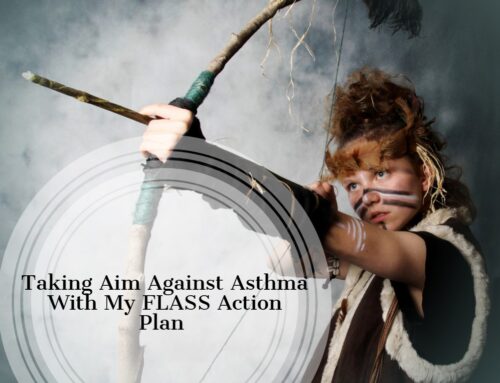Every asthma sufferer has a different pattern of triggers. Globally, the World Health Organization
calculates that at least 235 million people suffer with asthma. FLASS knows that each of them has an individualized set of asthma triggers.
 Mayo Clinic defines such triggers as “various irritants and substances that trigger allergies (allergens)…” They add that these triggers, once encountered, initiate the signs and symptoms of asthma…”
Mayo Clinic defines such triggers as “various irritants and substances that trigger allergies (allergens)…” They add that these triggers, once encountered, initiate the signs and symptoms of asthma…”
Triggers: A Different Signature Set For Every Patient!
Usually encountering a trigger means the patient will endure a sudden onset of coughing, choking, and wheezing.
Mayo Clinic also adds, “Asthma triggers are different from person to person.” You might already know that the classification “triggers” can include widely diversified irritants like smoke, sudden cold air, allergens, beta blockers, GERD and exercise.
You probably have guessed; almost any irritant or allergen can be an asthma trigger!
Doctors and staff at Florida Lung, Asthma and Sleep Specialists believe you can better understand the amazing individuality of the disease by imagining hundreds of triggers that might instigate a choking attack. Now, multiply them by mathematical combinations possible, and you can imagine the challenges we see patients fighting every day.
FLASS knows that part of the key to controlling asthma is identifying a patient’s individual list of probable triggers. Then, of course, it is up to the asthma patient to lead a life that avoids their particular triggers.
Read on, and we will tell you more specific triggers. First, let’s establish a few basics about Asthma
After the Trigger, Comes the Attack!
A summary of what happens when asthma is triggered goes beyond our usual understanding of a typical cough. Let’s look at it in some steps:
1. Inflamed Airways: Having the disease of Asthma generally means a patient has inflammation in the airways. As you might imagine, inflammation causes the tissue of the airways to swell and in turn to be acutely sensitive. This sets the stage for strong reactions to specified inhaled substance.
2. A Reaction In The Airways: Muscles tighten against airways when the airways swell and hurt. Sometimes the airways begin to make heavy, tacky mucus. Thus the airways become even more constricted and the lungs get less air flow.
3. Signs and Symptoms: The Cough-Choke-Wheeze Syndrome: The circular reaction above results in asthma symptoms. Sometimes the reaction just goes away, or removing the irritant results in ceasing the symptoms.
Other times, only medication can stop the “chain reaction.” And the National Heart, Lung and Blood Institute warns, “Symptoms can happen each time the airways are inflamed.”
Basic Causes of Asthma: A Separate Category From Triggers
Science tells us that a combination of factors causes asthma. Both genetics and environmental conditions advance the disease. Have you ever noticed how “Asthma tends to run in families, suggesting an inherited component to the disease?” It seems to be true that “You’re more likely to have asthma if your parents have It.”
Here are a few other usual suspects that can directly cause crime of this disease:
1. Atopic Syndrome: This simply means you have allergic hypersensitivity or atopic eczema and allergic rhinitis. Having respiratory infections during infancy or early childhood is another risk factor for asthma.
These infections can cause inflammation in the lungs and damage lung tissue, affecting lung function later in life.
2. Infant Viral Infections and Airborne Allergens or Irritants: Infants or children who have early exposure to Viruses and Irritants are dealing with conditions before their immune system is even matured. Thus, they often risk developing asthma.
3. Before Birth Exposure: The National Institute of Health also warns that a woman’s eating or smoking habits can cause her child to risk asthma later in life.
4. Allergic Asthma: The science behind allergic asthma states that “the immune system reacts to harmless substances in the environment by releasing antibodies called immunoglobulin E.” The problem doesn’t end there. “These antibodies cause certain immune system cells to release chemicals that produce inflammation in the lungs.”
Asthma Triggers: The 2017 Hit Parade!
Just as we promised, below is a list of many of the typical triggers for asthma. Undoubtedly a few of them will surprise you:
Cockroaches,
Mold and Fungi,
Pollen,
Some foods and food additives,
Household dust mites,
Airborne Irritants: Here we almost need a “sub” list to bring you the roll call of guilty triggers like industrial emissions, vehicle exhaust, ozone, smoke from cigarettes, burning wood, burning grass, smog, or sulfur dioxide.
Pet dander (skin flakes) from household animals. We also have to include their urine, feces, saliva, and, of course, their hair,

With attention to triggers, FLASS patients are prepared for Asthma Attacks.
Respiratory Infections: Long or short in duration, weak or strong in intensity, almost like the patient reacts allergically to the virus.
Exercise-Induced Asthma: According to Every Day Health. Com, “this condition was previously known as exercise-induced asthma…” Now it is termed Exercise-Induced Bronchoconstriction, or EIB.
Did you know that some people who do not have asthma, especially if they are in weak physical shape, can also have the EIB symptoms?
Likewise, the Asthma and Allergy Foundation of America reports that 90 percent of asthma patients suffer from some sort of airflow difficulties and asthma symptoms at some point in an exercise session.
But that is another blog topic, deserving a bit more detail! Remember, May is Asthma Advocacy Month, and we will be bringing you more asthma-related information next week!



